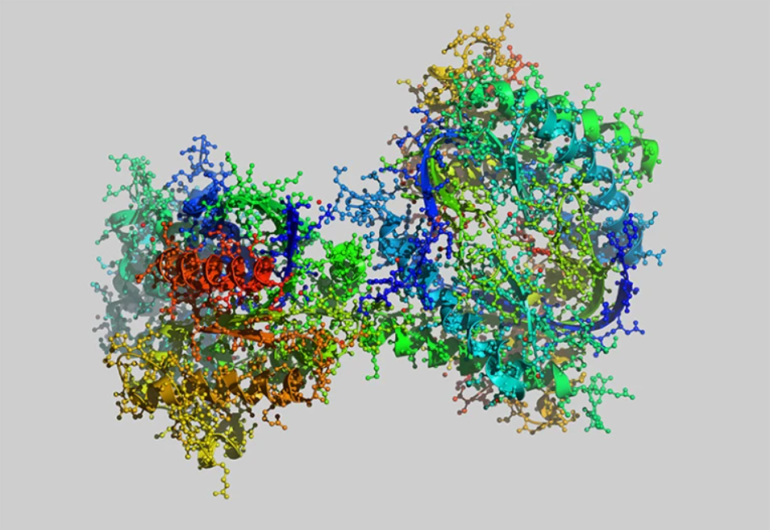TL;DR:
- Self-driving laboratory, driven by AI, reengineers enzymes with minimal human intervention.
- This innovation automates protein engineering, utilizing robotic equipment and machine-learning models.
- Researchers aim to accelerate scientific progress and discover novel solutions.
- Protein engineering, known for its monotony, finds an ideal candidate in self-driving labs.
- A simple machine-learning model guides experiments, improving enzyme functionality.
- The study successfully enhanced enzyme tolerance to high temperatures.
- Autonomous labs significantly reduce time and cost compared to human-led efforts.
- Challenges include hardware enhancement and knowledge interpretation by machines.
- Future applications and advancements in deep learning tools are being explored.
- The goal is not to replace human scientists but to eliminate tedious tasks.
Main AI News:
In a groundbreaking feat of innovation, a ‘self-driving’ laboratory, guided by a rudimentary artificial intelligence (AI) model, has effectively reengineered enzymes with minimal human intervention—limited to occasional hardware adjustments. This remarkable advancement is spearheading the transformation of protein engineering, fully automating the process through a fusion of robotic equipment and machine-learning models. Héctor García Martín, a physicist and synthetic biologist at Lawrence Berkeley National Laboratory in Berkeley, California, lauds this endeavor as “cutting-edge work” that is poised to revolutionize the scientific landscape.
The convergence of robotic equipment and machine learning has given birth to autonomous laboratories, capable of orchestrating experiments and deciphering outcomes to craft novel procedures. The aspiration of researchers is that these autonomous labs will expedite the scientific journey and unearth solutions that might have eluded human imagination.
Protein engineering, a rather monotonous undertaking, is an ideal candidate for self-driving labs, according to Philip Romero, a protein engineer at the University of Wisconsin–Madison, who spearheaded a study published on 11 January in Nature Chemical Engineering. Traditional methodologies typically entail developing an assay for a specific property, such as enzyme activity, followed by screening an extensive array of mutated protein variants. Romero emphasizes, “So much of the field of protein engineering is monotonous.”
The system devised by Romero’s team relies on a relatively straightforward machine-learning model linking a protein’s sequence to its function. This model suggests sequence alterations to enhance functionality. It dispatches protein sequences for testing to lab equipment, which synthesizes the proteins, measures their activity, and then relays the results to the model for guidance in subsequent experiments. “We set and forget it,” Romero states.
In the study, the researchers tasked their self-driving laboratory with enhancing the tolerance of metabolic enzymes known as glycoside hydrolases to high temperatures. After 20 rounds of experimentation, each comprising four campaigns, the autonomous lab produced novel enzyme variants capable of operating at temperatures at least 12 ˚C higher than the initial proteins.
Initially, the researchers attempted to operate their robotic equipment, but they faced persistent breakdowns. Consequently, they turned to a cloud-based laboratory in California—an existing facility equipped with remote-controlled robotic equipment—and configured their AI model to issue instructions from afar. The entire experiment spanned approximately six months, including a 2.5-month hiatus due to shipping delays, and incurred an estimated cost of around US$5,200 for each 20-round cycle, which contrasts markedly with the potentially year-long duration required by a human to achieve the same results.
While augmenting the capabilities of self-driving biology labs may necessitate advanced hardware, García Martín highlights the primary challenge of enabling these labs to generate knowledge interpretable by both machines and humans.
Huimin Zhao, a synthetic biologist at the University of Illinois Urbana–Champaign, points out that making proteins more heat stable is relatively straightforward, but the adaptability of the self-driving lab to modify enzymes in other ways remains uncertain.
Romero’s team is actively exploring the application of their self-driving lab to tackle diverse protein-engineering challenges. Additionally, they aspire to integrate more advanced deep-learning tools that have driven progress in protein design. Importantly, the researchers emphasize that their aim is not to diminish the role of the scientific workforce but rather to supplant the tedious aspects, enabling scientists to focus on the more engaging facets of their engineering work.
Conclusion:
The emergence of AI-powered self-driving labs is poised to revolutionize the protein engineering landscape. These autonomous laboratories, combining robotic equipment and machine learning, offer the potential to accelerate scientific discoveries and streamline experimentation. While challenges remain, such as hardware upgrades and knowledge interpretation, the objective is to enhance efficiency and free scientists from mundane tasks, ultimately driving innovation in the market.

